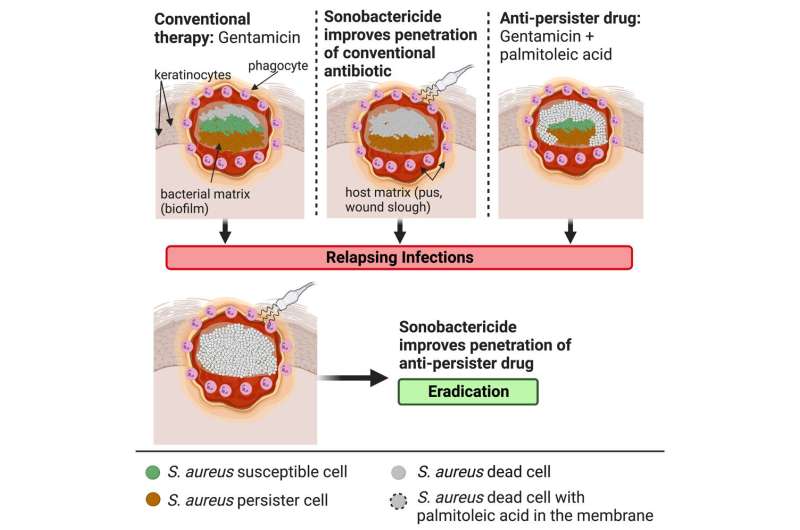This article has been reviewed according to Science X's editorial process and policies. Editors have highlighted the following attributes while ensuring the content's credibility:
fact-checked
peer-reviewed publication
trusted source
proofread
Breaking through bacterial barriers in chronic treatment-resistant wounds

Chronic wounds are open sores or injured tissue that fail to heal properly. These types of wounds are notoriously challenging to treat because of bacterial infections like Staphylococcus aureus, or S. aureus. Additionally, bacterial infections that are highly resistant to antibiotics, such as methicillin-resistant S. aureus (MRSA), are one of the main causes of life-threatening infections in hospital patients.
To defend itself from our immune system and other threats, S. aureus can band together, creating a slick, slimy forcefield—or biofilm—around itself. The biofilm barrier is so thick that neither immune cells nor antibiotics can penetrate through and neutralize the harmful bacteria.
Researchers at the UNC School of Medicine and the UNC-NC State Joint Department of Biomedical Engineering have developed a new method that combines palmitoleic acid, gentamicin, and non-invasive ultrasound to help improve drug delivery in chronic wounds that have been infected with S. aureus.
Using their new strategy, researchers were able to reduce the challenging MRSA infection in the wounds of diabetic mice by 94%. They were able to completely sterilize the wounds in several of the mice, and the rest had significantly reduced bacterial burden. Their results were published in Cell Chemical Biology.
"When bacteria are not completely cleared from chronic wounds, it puts the patient at high risk for the infection recurring or of developing a secondary infection," said senior author Sarah Rowe-Conlon, Ph.D., a research associate professor in the Department of Microbiology and Immunology. "This therapeutic strategy has the potential to improve outcomes and reduce relapse of chronic wound infections in patients. We are excited about the potential of translating this to the clinic, and that's what we're exploring right now."
Biofilms act as a physical barrier to many classes of antibiotics. Virginie Papadopoulou, Ph.D., a research assistant professor in the UNC-NCSU Joint Department of Biomedical Engineering, was curious to know if non-invasive cavitation-enhanced ultrasound could create enough agitation to form open spaces in the biofilm to facilitate drug-delivery.
Liquid droplets which can be activated by ultrasound, called phase change contrast agent (PCCA), are applied topically to the wound. An ultrasound transducer is focused on the wound and turned on, causing the liquid inside the droplets to expand and turn into microscopic gas-filled microbubbles, when then move rapidly.
The oscillation of these microbubbles agitates the biofilm, both mechanically disrupting it as well as increasing fluid flow. Ultimately, the combination of the biofilm disruption and the increased permeation of the drugs through the biofilm allowed the drugs to come in and kill the bacterial biofilm with very high efficiency.
"Microbubbles and phase change contrast agents act as local amplifiers of ultrasound energy, allowing us to precisely target wounds and areas of the body to achieve therapeutic outcomes not possible with standard ultrasound," said Dayton, the William R. Kenan Jr. Distinguished Professor and Department Chair of the UNC-NCSU Joint Department of Biomedical Engineering. "We hope to be able to use similar technologies to locally delivery chemotherapeutics to stubborn tumors or drive new genetic material into damaged cells as well."
When the bacterial cells are trapped inside the biofilm, they are left with little access to nutrients and oxygen. To conserve their resources and energy, they transition into a dormant or sleepy state. The bacteria, which are known as persister cells in this state, are extremely resistant to antibiotics.
Researchers chose gentamicin, a topical antibiotic typically ineffective against S. aureus due to widespread antibiotic resistance and poor activity against persister cells. The researchers also introduced a novel antibiotic adjuvant, palmitoleic acid, to their models.
Palmitoleic acid, an unsaturated fatty acid, is a natural product of the human body that has strong antibacterial properties. The fatty acid embeds itself into the membrane of bacterial cells, and the authors discovered that it facilitates the antibiotic's successful entry into S. aureus cells and is able to kill persister cells and reverse antibiotic resistance.
Overall, the team is enthusiastic about the new topical, non-invasive approach because it may give scientists and doctors more tools to combat antibiotic resistance and to lessen the serious adverse effects of taking oral antibiotics.
"Systemic antibiotics, such as oral or IV, work very well, but there's often a large risk associated with them such as toxicity, wiping out gut microflora and C. difficile infection," said Rowe-Conlon. "Using this system, we are able to make topical drugs work and they can be applied to the site of infection at very high concentrations, without the risks associated with systemic delivery."
More information: Virginie Papadopoulou et al, Overcoming biological barriers to improve treatment of a Staphylococcus aureus wound infection, Cell Chemical Biology (2023). DOI: 10.1016/j.chembiol.2023.04.009



















